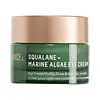What's inside
What's inside
 Key Ingredients
Key Ingredients

 Benefits
Benefits

 Concerns
Concerns

 Ingredients Side-by-side
Ingredients Side-by-side

Water
Skin ConditioningCaprylic/Capric Triglyceride
MaskingSqualane
EmollientGlycerin
HumectantSorbitan Olivate
EmulsifyingCetearyl Olivate
Jojoba Esters
EmollientGlyceryl Stearate Se
EmulsifyingPanthenol
Skin ConditioningHydroxyethyl Acrylate/Sodium Acryloyldimethyl Taurate Copolymer
Emulsion StabilisingCetyl Palmitate
EmollientSpilanthes Acmella Flower Extract
Skin ConditioningPalmitoyl Tripeptide-5
Skin ConditioningSorbitan Palmitate
EmulsifyingDunaliella Salina Extract
Skin ConditioningAstaxanthin
Skin ConditioningSodium Hyaluronate
HumectantPhenoxyethanol
PreservativeEthylhexylglycerin
Skin ConditioningTocopherol
AntioxidantCitric Acid
BufferingWater, Caprylic/Capric Triglyceride, Squalane, Glycerin, Sorbitan Olivate, Cetearyl Olivate, Jojoba Esters, Glyceryl Stearate Se, Panthenol, Hydroxyethyl Acrylate/Sodium Acryloyldimethyl Taurate Copolymer, Cetyl Palmitate, Spilanthes Acmella Flower Extract, Palmitoyl Tripeptide-5, Sorbitan Palmitate, Dunaliella Salina Extract, Astaxanthin, Sodium Hyaluronate, Phenoxyethanol, Ethylhexylglycerin, Tocopherol, Citric Acid
Aloe Barbadensis Leaf Juice
Skin ConditioningHelianthus Annuus Seed Oil
EmollientIsoamyl Laurate
EmollientRosa Damascena Flower Water
MaskingGlyceryl Stearate Citrate
EmollientCetearyl Alcohol
EmollientGlyceryl Caprylate
EmollientPopulus Tremuloides Bark Extract
AntiseborrhoeicAleurites Moluccanus Seed Oil
Skin ConditioningPropanediol
SolventMyrothamnus Flabellifolia Extract
HumectantAscorbic Acid
AntioxidantCitric Acid
BufferingGlycerin
HumectantNelumbo Nucifera Extract
Skin ConditioningButyrospermum Parkii Butter
Skin ConditioningOryza Sativa Extract
AbsorbentCamellia Sinensis Leaf Extract
AntimicrobialSodium Hyaluronate
HumectantMelia Azadirachta Flower Extract
Skin ConditioningCorallina Officinalis Extract
Skin ConditioningCoccinia Indica Fruit Extract
Skin ConditioningMelia Azadirachta Leaf Extract
Skin ConditioningSolanum Melongena Fruit Extract
Skin ConditioningAloe Barbadensis Flower Extract
EmollientOcimum Sanctum Leaf Extract
Skin ConditioningCurcuma Longa Root Extract
MaskingRosmarinus Officinalis Leaf Extract
AntimicrobialSclerotium Gum
Emulsion StabilisingRosa Damascena Flower Oil
MaskingXanthan Gum
EmulsifyingSodium Phytate
Alcohol
AntimicrobialSodium Anisate
AntimicrobialAloe Barbadensis Leaf Juice, Helianthus Annuus Seed Oil, Isoamyl Laurate, Rosa Damascena Flower Water, Glyceryl Stearate Citrate, Cetearyl Alcohol, Glyceryl Caprylate, Populus Tremuloides Bark Extract, Aleurites Moluccanus Seed Oil, Propanediol, Myrothamnus Flabellifolia Extract, Ascorbic Acid, Citric Acid, Glycerin, Nelumbo Nucifera Extract, Butyrospermum Parkii Butter, Oryza Sativa Extract, Camellia Sinensis Leaf Extract, Sodium Hyaluronate, Melia Azadirachta Flower Extract, Corallina Officinalis Extract, Coccinia Indica Fruit Extract, Melia Azadirachta Leaf Extract, Solanum Melongena Fruit Extract, Aloe Barbadensis Flower Extract, Ocimum Sanctum Leaf Extract, Curcuma Longa Root Extract, Rosmarinus Officinalis Leaf Extract, Sclerotium Gum, Rosa Damascena Flower Oil, Xanthan Gum, Sodium Phytate, Alcohol, Sodium Anisate
 Reviews
Reviews

Ingredients Explained
These ingredients are found in both products.
Ingredients higher up in an ingredient list are typically present in a larger amount.
Citric Acid is an alpha hydroxy acid (AHA) naturally found in citrus fruits like oranges, lemons, and limes.
Like other AHAs, citric acid can exfoliate skin by breaking down the bonds that hold dead skin cells together. This helps reveal smoother and brighter skin underneath.
However, this exfoliating effect only happens at high concentrations (20%) which can be hard to find in cosmetic products.
Due to this, citric acid is usually included in small amounts as a pH adjuster. This helps keep products slightly more acidic and compatible with skin's natural pH.
In skincare formulas, citric acid can:
While it can provide some skin benefits, research shows lactic acid and glycolic acid are generally more effective and less irritating exfoliants.
Most citric acid used in skincare today is made by fermenting sugars (usually from molasses). This synthetic version is identical to the natural citrus form but easier to stabilize and use in formulations.
Read more about some other popular AHA's here:
Learn more about Citric AcidGlycerin is already naturally found in your skin. It helps moisturize and protect your skin.
A study from 2016 found glycerin to be more effective as a humectant than AHAs and hyaluronic acid.
As a humectant, it helps the skin stay hydrated by pulling moisture to your skin. The low molecular weight of glycerin allows it to pull moisture into the deeper layers of your skin.
Hydrated skin improves your skin barrier; Your skin barrier helps protect against irritants and bacteria.
Glycerin has also been found to have antimicrobial and antiviral properties. Due to these properties, glycerin is often used in wound and burn treatments.
In cosmetics, glycerin is usually derived from plants such as soybean or palm. However, it can also be sourced from animals, such as tallow or animal fat.
This ingredient is organic, colorless, odorless, and non-toxic.
Glycerin is the name for this ingredient in American English. British English uses Glycerol/Glycerine.
Learn more about GlycerinSodium Hyaluronate is hyaluronic acid's salt form. It is commonly derived from the sodium salt of hyaluronic acid.
Like hyaluronic acid, it is great at holding water and acts as a humectant. This makes it a great skin hydrating ingredient.
Sodium Hyaluronate is naturally occurring in our bodies and is mostly found in eye fluid and joints.
These are some other common types of Hyaluronic Acid:
Learn more about Sodium Hyaluronate